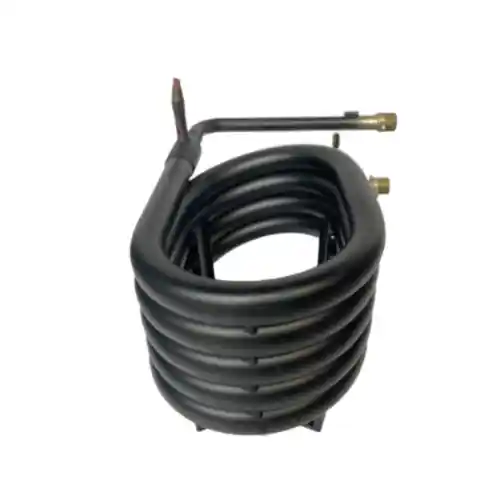1. Introduction
Copper-aluminum composite tubes have gained significant attention in the field of coaxial heat exchangers due to their unique properties and potential for improving heat transfer efficiency. This article explores the characteristics of copper-aluminum composite tubes, their advantages, and their impact on the performance of coaxial heat exchangers. We will discuss the composition of composite tubes, their thermal conductivity, corrosion resistance, and compare them with other tube materials commonly used in heat exchangers.
2. Composition and Structure of Copper-Aluminum Composite Tubes
Copper-aluminum composite tubes are constructed by bonding copper and aluminum layers together. The composite structure typically consists of an inner copper tube and an outer aluminum tube. The following table provides an overview of the composition and structure of copper-aluminum composite tubes:
| Composite Tube Structure | Composition |
|---|---|
| Inner Tube | Copper (Cu) |
| Outer Tube | Aluminum (Al) |
| Bonding Layer | Aluminum/Copper interface or intermediate layer (Cladding) |
3. Advantages of Copper-Aluminum Composite Tubes in Coaxial Heat Exchangers
3.1 Enhanced Heat Transfer Efficiency
Copper-aluminum composite tubes combine the advantages of both copper and aluminum. The inner copper tube provides excellent thermal conductivity, while the outer aluminum tube contributes to lightweight construction and corrosion resistance. This combination results in enhanced heat transfer efficiency in coaxial heat exchangers.
3.2 Improved Corrosion Resistance
The aluminum outer layer of composite tubes acts as a protective barrier against corrosive environments, while the inner copper tube ensures efficient heat transfer. This dual-layered structure enhances the overall corrosion resistance of the tubes, making them suitable for a wide range of applications.
3.3 Weight Reduction
Compared to solid copper tubes, copper-aluminum composite tubes offer significant weight reduction benefits due to the lightweight nature of aluminum. This weight reduction not only facilitates easier installation but also reduces the overall weight of the coaxial heat exchanger, making it more suitable for applications where weight is a critical factor.
3.4 Cost-Effectiveness
Copper-aluminum composite tubes offer a cost-effective alternative to solid copper tubes. The use of aluminum as the outer layer reduces material costs, while maintaining the desired thermal conductivity of copper. Additionally, the composite structure enables efficient use of materials, reducing overall production costs.
4. Comparison with Other Tube Materials
4.1 Copper Tubes
Copper tubes are widely used in heat exchangers due to their excellent thermal conductivity and corrosion resistance. However, compared to copper-aluminum composite tubes, solid copper tubes tend to be heavier and more expensive. The following table provides a comparison between copper and copper-aluminum composite tubes:
| Material | Corrosion Resistance | Strength | Thermal Conductivity (W/m·K) | Weight (g/cm³) |
|---|---|---|---|---|
| Cobre | Excellent | Moderate | 385 | 8.96 |
| Copper-Aluminum Composite Tubes | Good | Moderate | Comparable to copper | Lighter |
4.2 Aluminum Tubes
Aluminum tubes offer lightweight construction and good thermal conductivity, but their corrosion resistance is inferior to that of copper and copper-aluminum composite tubes. The comparison between aluminum and copper-aluminum composite tubes is provided in the table below:
| Material | Corrosion Resistance | Strength | Thermal Conductivity (W/m·K) | Weight (g/cm³) |
|---|---|---|---|---|
| Aluminum | Good | Moderate | 167-237 | 2.70 |
| Copper-Aluminum Composite Tubes | Good | Moderate | Comparable to aluminum | Lighter |
5. Applications of Copper-Aluminum Composite Tubes in Coaxial Heat Exchangers
Copper-aluminum composite tubes find diverse applications in coaxial heat exchangers across various industries. Some notable applications include:
5.1 HVAC Systems
Coaxial heat exchangers with copper-aluminum composite tubes are widely used in heating, ventilation, and air conditioning (HVAC) systems. Their enhanced heat transfer efficiency, corrosion resistance, and weight reduction benefits contribute to improved HVAC system performance.
5.2 Refrigeration
Copper-aluminum composite tubes are suitable for heat exchangers used in refrigeration systems. Their thermal conductivity and corrosion resistance help maintain efficient heat transfer and prevent refrigerant leakage.
5.3 Industrial Processes
Coaxial heat exchangers with copper-aluminum composite tubes are employed in various industrial processes, including chemical, oil, and gas industries. The lightweight nature and corrosion resistance of composite tubes make them ideal for handling corrosive fluids and optimizing heat transfer.
6. Conclusion
Copper-aluminum composite tubes offer significant advantages in coaxial heat exchangers, including enhanced heat transfer efficiency, improved corrosion resistance, weight reduction, and cost-effectiveness. The combination of copper and aluminum in a composite structure allows for optimal utilization of their individual properties. Compared to solid copper and aluminum tubes, copper-aluminum composite tubes provide a balance between thermal conductivity, corrosion resistance, and weight reduction. These tubes find widespread applications in HVAC systems, refrigeration, and various industrial processes. By incorporating copper-aluminum composite tubes, engineers and designers can optimize the performance and efficiency of coaxial heat exchangers in diverse industrial sectors.


